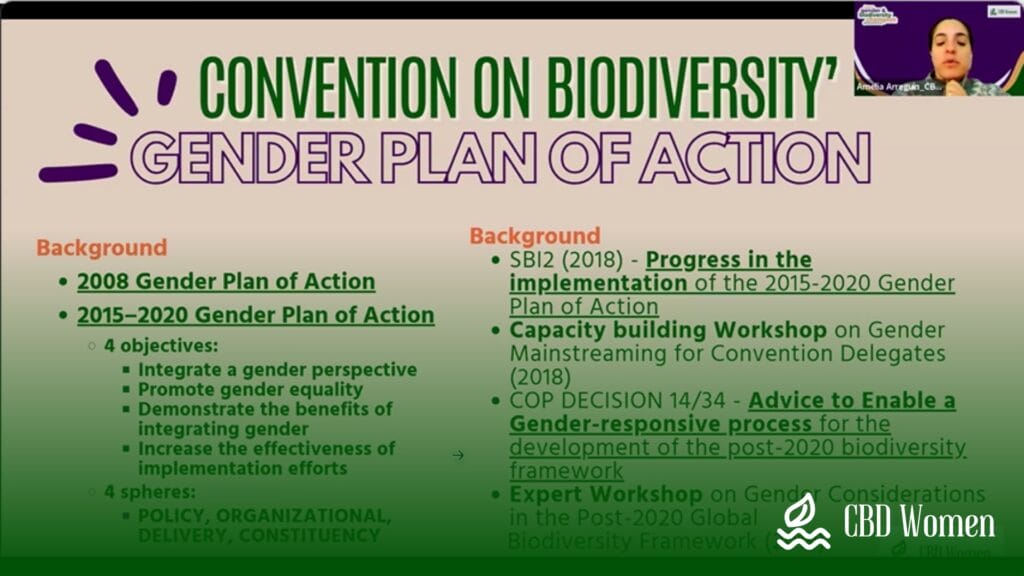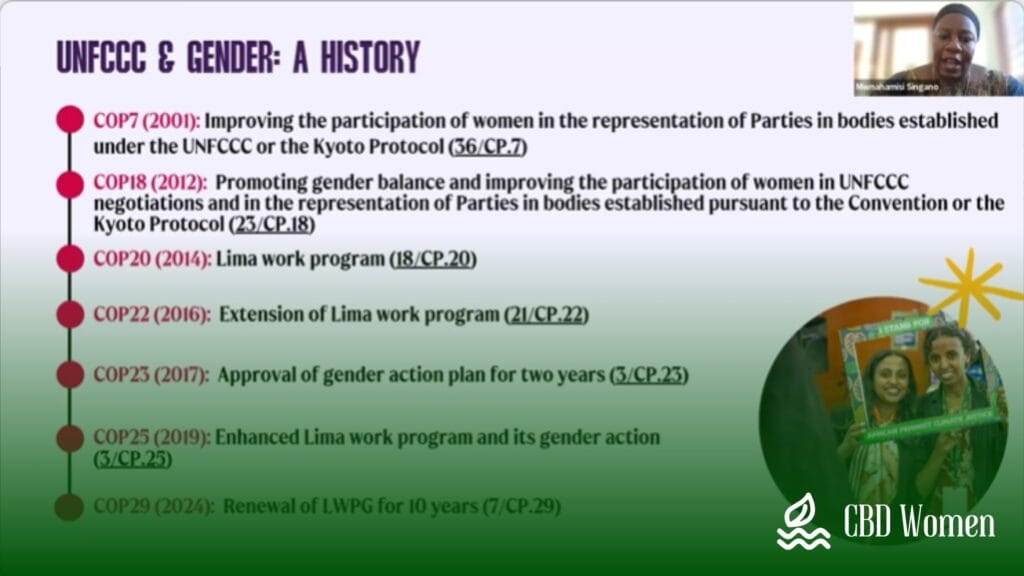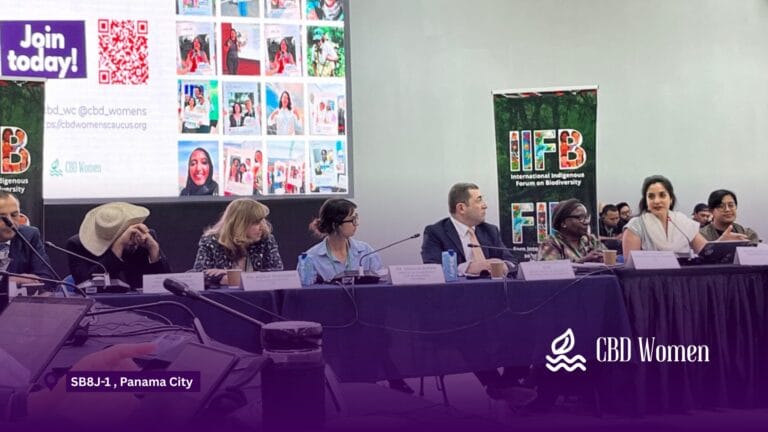On Tuesday, November 4, 2025, the CBD Women’s Caucus and the UNFCCC Women and Gender Constituency (WGC) convened a dynamic cross-learning online session around the Biodiversity & Climate Gender Action Plans. This vibrant session brought together Women and girls’ rights advocates from both the biodiversity and climate spaces, providing a platform to identify the gaps, share lessons, explore synergies, and strengthen coherence across the Rio Conventions. The event aimed to advance gender-transformative and intersectional advocacy, ensuring that gender responsiveness considerations remain central to environmental decision-making at all levels.

Lessons from the CBD Gender Plan of Action
The webinar began with Ms. Amelia Arreguin Prado, coordinator of the CBD Women’s Caucus, providing a detailed overview of the CBD Gender Plan of Action (GPA) and its evolution over time. The first GPA, launched in 2008, primarily focused on integrating gender within the internal work of the CBD Secretariat. The second plan, covering 2015 to 2020, expanded its scope to include policy, organizational, and national implementation, demonstrating how gender perspectives could enhance biodiversity policy effectiveness. Reflections on this second plan revealed that mainstreaming gender in policy alone was not enough to achieve transformative change, paving the way for the current CBD GPA (2023–2030).
The present plan represents a major advancement, designed as a strategic instrument with clear objectives, actionable steps, timelines, and designated actors to strengthen monitoring and accountability. It supports gender-responsive implementation of the Global Biodiversity Framework,as well as other key CBD instruments such as its Resource mobilisation strategy, the Communication and education plan, and the Monitoring framework. Its three central outcomes focus on ensuring that women and girls have equal opportunity to contribute to CBD objectives, that biodiversity policy and planning are gender-responsive, and that enabling conditions, such as national capacities, data collection, public participation, and resource allocation, are in place for effective implementation.
A particularly groundbreaking element of the CBD GPA is Objective 1.5, which explicitly addresses the elimination, prevention, and response to all forms of gender-based violence within biodiversity contexts. This makes the CBD GPA one of the few environmental policy instruments globally to confront gender-based violence directly. Ms Arreguin also highlighted advocacy initiatives such as the Gender and Biodiversity Champion campaign, encouraging stakeholders to actively engage with the gender plan of action and implement its actions, ensuring it remains a living and actionable instrument rather than a document left on the shelf.

Lessons from the UNFCCC Gender Action Plan
Ms. Mwanahamisi Singano, coordinator of the Women and Gender Constituency (WGC) and policy director at Women’s Environment & Development Organization (WEDO), shared insights on the UNFCCC Gender Plan of Action (GPA). She outlined its historical context, tracing the evolution of gender considerations within the UNFCCC framework. This review included COP7 in 2001 with the first gender reference on participation, COP20 in 2014 with the adoption of the Lima Work Programme on Gender, COP25 in 2019 which combined a renewed work programme with the first Gender Action Plan, and COP29 in 2024 where the Lima Work Programme was renewed for ten years, setting the stage for adoption of the next Gender Action Plan at COP30 in Belém.
She emphasized that the UNFCCC GPA prioritizes capacity building, knowledge management, gender balance and leadership, coherent gender-responsive implementation, and robust monitoring and reporting. Lessons from past implementation revealed that National Climate Change Focal Points have been instrumental in institutionalizing gender action, yet challenges such as coordination gaps, unclear mandates, insufficient resources, and event-based approaches limited the plan’s impact. Importantly, previous iterations often overlooked intersectionality, missing rural, indigenous, urban poor, and differently-abled women.
Looking ahead, Ms. Singano stressed that the upcoming GPA aims to embrace intersectionality, ensure measurable outcomes, allocate sufficient resources, and foster stronger coherence across the Rio Conventions. She highlighted that earlier workshops had produced a draft plan with over a hundred deliverables, including some to improve coordination among UNFCCC, CBD, and UNCCD focal points. Her call to women and girls’ rights advocates was clear: push for a comprehensive, inclusive, and well-resourced Gender Action Plan in Belém (COP30), building on lessons learned from both the CBD GPA and prior UNFCCC implementation experiences.

Women’s Land Rights: A Strategic Lever for Coherence
Ms. Ilse Pelkmans, Program Manager for TMG Research, highlighted the central role of women’s land rights in achieving gender-responsive environmental action across the Rio Conventions.” Land lies at the heart of mitigation and adaptation under the UNFCCC, biodiversity protection under the CBD, and restoration under the UNCCD. Secure access to land and resources for women is not only a human rights issue but also a strategic lever for effective policy implementation, advocacy, and coherence across conventions.”
Ms. Pelkmans’ analysis of the three Gender Action Plans highlighted the recognition of gender justice as essential for environmental action, the explicit inclusion of human rights, promotion of women’s leadership in land-use decisions, technical and financial support for grassroots organizations, and the need for gender-responsive budgeting with harmonized, disaggregated indicators. Drawing lessons from the CBD, Ms. Pelkmans emphasized that secure ownership, decision-making participation, and alignment with SDGs serve as concrete examples for how the UNFCCC and UNCCD can strengthen their approaches, ensuring that women’s land rights are recognized, financed, monitored, and implemented in practice.

A Dynamic Exchange of Experiences and Strategies
The final segment of the webinar invited participants to share experiences, insights, and strategies from their advocacy at local, national, and international levels that could support the efforts for the UNFCCC GAP to be adopted and effectively implemented. Participants highlighted the importance of traditional knowledge and the often-unrecognized unpaid care work of women, emphasizing the need for policies that reflect local adaptation practices. They also discussed effective advocacy strategies, noting the value of structured escalation and engaging multiple levels of authority to ensure responsiveness and accountability.
Strengthening locally led leadership development, direct funding mechanisms, and economic autonomy were recognized as essential for driving meaningful change. Participants reflected on the value of linking formal and non-formal education with community knowledge holders, recognizing the vital contributions of local biodiversity defenders. The conversation also emphasized showcasing successful initiatives to inspire women, strengthen networks, and enhance coordination across movements and international frameworks.
In sum, this cross learning session between the Women/Gender Caucus from CBD and UNFCCC offered knowledge and practical insights that can directly inform and strengthen the implementation of Gender Action Plans, fostering collaboration and reinforcing the transformative potential of gender-responsive environmental action.





